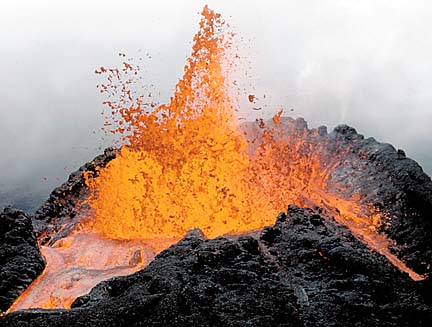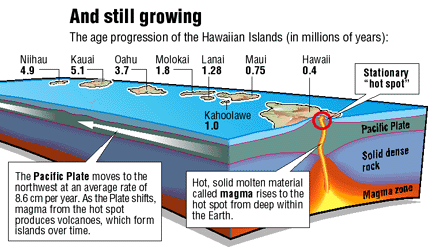

Prehistory to 1780: Ancient Hawaii
to Western Discovery

O ke au i kahuli wela ka honua Kumulipo
O ke au i kahuli lole ka lani
O ke au i kuka'iaka ka la
E ho'omalamalama i ka malama
O ke au o Makali'i ka po
O ka walewale ho'okumu honua ia
O ke kumu o ka lipo, i lipo ai
O ke kumu o ka po, i po ai
O ka lipolipo, o ka lipolipo
O ka lipo o ka la, o ka lipo o ka po
Po wale ho'i
O paia'a i ke auau ka manawa
O he'e au loloa ka po
O piha, o pihapiha
O piha-u, o piha-a
O piha-e, o piha-o
O ke ko'o honua pa'a ka lani
O lewa ke au, ia Kumulipo ka po
Po noAt the time when the Earth became hot
At the time when the heavens turned about
At the time when the sun was darkened
To cause the moon to shine
The time of the rise of the Pleiades
The slime, this was the source of the Earth
The source of the darkness that made darkness
The source of the night that made night
The intense darkness, the deep darkness
Darkness of the sun, darkness of the night
Nothing but night
Multiplying in the passing time
The long night slips along
Fruitful, very fruitful
Spreading here, spreading there
Spreading this way, spreading that way
Propping up Earth, holding up the sky
The time passes. this night of Kumulipo
Still it is night-- From the Hawaiian creation chant 'Kumulipo'
Undersea volcanoes gave life
By Richard Borreca
to Hawaii millions of years ago
—and continue today
Star-BulletinImagine the forces that lift us from the water.
Consider the power that heaves up rock, the energy that heats our Earth's middle, pushing not just stone, not just the ocean floor but making continents groan and shake.
Hawaii's heroic myths and opulent history are worlds away from the brutal, remorseless, ever-churning geology starting 1,800 miles below us.
Geologists call it a hot spot: a plume of hot rock about 250 miles wide running down to Earth's molten iron core. It is the biggest hot spot in the world -- ten times bigger than anyplace else.
The University of Hawaii's David Bercovici, an international award-winning geophysicist, explains that the plume, about 2,370 degrees Fahrenheit, rises to the Pacific Ocean plate, where it melts the rock.

The rock turns to magma, which breaks out of the Earth's crust as lava. It is 2,000 degrees when it hits the frigid Pacific Ocean.Nowhere else does this happen with more power or frequency than in Hawaii, Bercovici explains.
It started more than 60 million years ago in deep underwater explosions. Tremendous heat from the hard rock and then the lava struggled upward -- forcing their way to the Earth's crust, the ocean floor. Cracks opened, lava roared furiously in contact with the cool water and from the ocean, inch by inch, islands rose.
The chain's ancient islands rode the Hawaiian plate northwest across the Pacific, cooling, dying, eroding, submerging -- until becoming the Emperor Seamounts buried in the Aleutian Trench.
About 43 million years ago, something mysterious happened: The islands stopped their orderly journey to the north and started moving west.
No one knows why. Geologists speculate that the collision of India into the Asian continent, which began about the same time, might have altered the journey. The result: A roughly L-shaped, regularly spaced chain from Hawaii to the Aleutian Islands.
The chain is anchored by Hawaii, crowned by Mauna Kea, the highest volcano in the world. Mauna Loa, still pouring out 2,000-degree lava along its flank, is the world's most massive.
The two volcanoes rise from the swell of the Hawaiian Ridge, which itself is a colossal platform, 500 miles wide and a half-mile above the surrounding ocean floor.
On that huge swell, the islands stage their life cycle.
Today on Oahu, for instance, we live on the remnants of two huge volcanoes, Waianae and Koolau.
First came Waianae, with violent eruptions that were so frequent that the forces of erosion could make little headway.
Eventually the Waianae summit sank, forming a crater or caldera. On the east side, lava flowed over the low crater wall. But on the other side, the high west wall blocked the coating flow of lava and erosion did its work. The results: the deep, majestic valleys of Lualualei, Makaha and Makua.
To the east, another volcano was rumbling its way to the surface: Koolau, which appeared a few million years after Waianae. The twin peaks continued to gush lava, filling the ocean between them with new land.
As the volcanism subsided, the pair rested -- and the forces of wind, rain and waves tore away at the huge mountains, says John Sinton, chairman of the UH Geology Department.
Then after millions of years of slumber, Oahu awoke. Cracks opened in a north-south direction, making the famous landscapes of Diamond Head and Koko Head, pouring forth lava flows that covered and flattened the floors of Manoa and Nuuanu valleys.
Before this second series of eruptions, however, huge sections of the islands collapsed and crashed into the sea, creating some of the biggest changes to the chain, the experts say.
As powerful as Hawaii's volcanoes were, they were not immune to ocean forces.
Great glaciers came and went across the continents, rising and lowering sea levels.
Beaches, tidal pools and valleys were covered or exposed by the waters.
About 80,000 years ago, for instance, the sea was perhaps 25 feet higher than it is now.
And it was a warmer ocean, which caused coral to grow. The coral, in time, formed broad plains.
The islands remain not of the sea, however, but of fire.
The wind, rain and waves beat down the huge lava mountains.
But as old islands to the east succumbed to the forces of erosion, a new island seethed into life here at the volcano's birthplace, Hawaii.
Millennium Series Archive